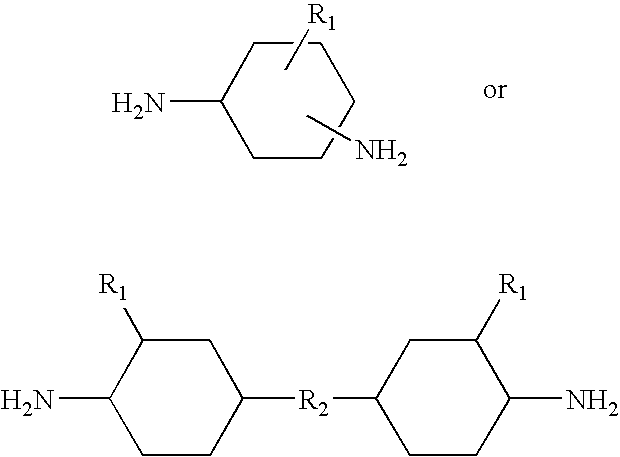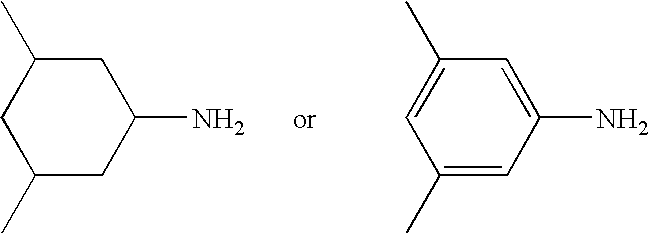Epoxy resin compositions
- Summary
- Abstract
- Description
- Claims
- Application Information
AI Technical Summary
Benefits of technology
Problems solved by technology
Method used
Image
Examples
preparation example 1
Ketimine derived from 1,2-diaminocyclohexane (DACH) and 4-methyl-2-pentanone (MIBK)
Into a 500 g-volume flask equipped with a magnetic stirrer, a thermometer, a nitrogen inlet device and Dean-Stark device were charged 57 g (0.5 mol) of 1,2-diaminocyclohexane and 250 g (2.5 mol) of 4-methyl-2-pentanone. The temperature was gradually raised up to 160° C. by heating with a mantle heater, while 4-methyl-2-pentanone was refluxed. The water distilled off during that period was collected into a separate vessel. When the amount of the water collected reached about 18 g, the temperature was raised and maintained at 180° C. for 2 hours to remove the remaining 4-methyl-2-pentanone. After cooling, 135 g of the desired ketimine was taken out as a residue in the flask. The product has a viscosity of 9.7 mPa·s at 25° C. and a calculated active hydrogen equivalent of 67.
preparation example 2
Ketimine derived from bis(aminocyclohexyl)methane (PACM) and 4-methyl-2-pentanon
Into the same equipment as in Preparation Example 1 were charged 105 g (0.5 mol) of bis(aminocyclohexyl)methane and 250 g (2.5 mol) of 4-methyl-2-pentanone and treated in the same manner as above. As a result, there was obtained 183 g of the ketimine from bis(aminocyclohexyl)-methane and 4-methyl-2-pentanone. This product has a viscosity of 180 mPa·s at 25° C. and a calculated active hydrogen equivalent of 92.
preparation example 3
Ketimine derived from a multifunctional polyamine (MPCA) and 4-methyl-2-pentanone
Into the same equipment as in Preparation Example 1 were charged 105 g of MPCA, which is prepared by hydrogenation of the oligomer obtained from condensation of aniline with formaldehyde and marketed under the trademark ANCAMINE 2167 curing agent from Air Products-Japan, and 250 g (2.5 mol) of 4-methyl-2-pentanone, and treated in the same manner as in Preparation Example 1. There was obtained 180 g of the ketimine of MPCA. This product has a viscosity of 200 mPa·s at 25° C., and a calculated active hydrogen equivalent of 90.
PUM
 Login to View More
Login to View More Abstract
Description
Claims
Application Information
 Login to View More
Login to View More - Generate Ideas
- Intellectual Property
- Life Sciences
- Materials
- Tech Scout
- Unparalleled Data Quality
- Higher Quality Content
- 60% Fewer Hallucinations
Browse by: Latest US Patents, China's latest patents, Technical Efficacy Thesaurus, Application Domain, Technology Topic, Popular Technical Reports.
© 2025 PatSnap. All rights reserved.Legal|Privacy policy|Modern Slavery Act Transparency Statement|Sitemap|About US| Contact US: help@patsnap.com



